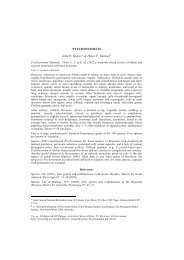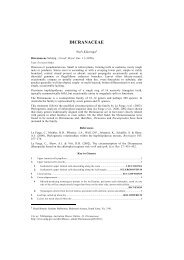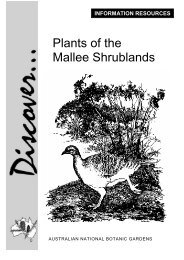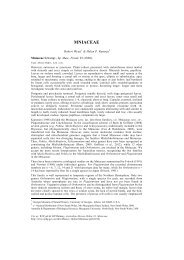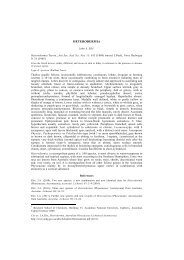FLORIBUNDARIA 1. Floribundaria floribunda (Dozy & Molk.) M ...
FLORIBUNDARIA 1. Floribundaria floribunda (Dozy & Molk.) M ...
FLORIBUNDARIA 1. Floribundaria floribunda (Dozy & Molk.) M ...
You also want an ePaper? Increase the reach of your titles
YUMPU automatically turns print PDFs into web optimized ePapers that Google loves.
egular rows over each cell from the acumen almost to the base, sublinear to hexagonal;<br />
acumen cells to 20–50 × 2 µm; upper and median cells ±sigmoid, to 50 × 5 µm; a few basal<br />
corner cells thicker-walled, c. 20 × 10 µm.<br />
Calyptra cucullate c. <strong>1.</strong>5 mm long, sparsely hairy. Seta blackish brown, 2.0–2.5 (–4.0) mm<br />
long, often curved. Capsules ovate-oblong, c. <strong>1.</strong>8 mm long and 0.8 mm wide; operculum c. 1<br />
mm long, conical-rostrate, with a long beak. Peristome: exostome teeth and endostome<br />
segments c. 0.5 mm long; segments broader. Spores 15–22 (–25) µm diam.<br />
Occurs in north-eastern Qld, where it is rare on trees and shrubs in tropical rainforest, mainly<br />
at altitudes of 400–1200 m. Also known from southern Africa, through Asia and the Pacific<br />
to Brazil.<br />
Qld: Mt Lewis, c. 100 NW of Cairns, B.O. van Zanten 681368A (GRO); Topaz Rd, 13 km SE of Malanda,<br />
H.Streimann 46686 (Musci Austral. Exs. 29) (CANB); Palmerston Natl Park, I.G.Stone 15133 (MELU).<br />
Stem leaves differ from branch leaves in having entire margins and long, often filiform<br />
apices, slightly broader median cells and more pronounced cell margins.<br />
2. <strong>Floribundaria</strong> pseudo<strong>floribunda</strong> M.Fleisch., Musc. Buitenzorg 3: 822 (1908)<br />
T: M.Fleischer, Musc. Archip. Ind. et Polynes. No. 435; holo: FH n.v.<br />
Illustrations: A.Noguchi, J. Hattori Bot. Lab. 41: 276 (1976); D.H.Norris & T.Koponen, Acta Bot. Fenn. 131:<br />
37 (1985); H.Streimann, J. Hattori Bot. Lab. 69: 296 (1991).<br />
Plants slightly glossy; stems to 4 cm long; branches <strong>1.</strong>0–<strong>1.</strong>5 mm long. Branch and stem<br />
leaves spreading when dry or moist. Branch leaves lanceolate or, rarely, ovate-oblong,<br />
usually c. <strong>1.</strong>6 × 0.4 mm, short-acuminate or narrowly acute; margin serrulate; costa faint,<br />
scarcely reaching mid-leaf, pale brown. Laminal cells obscure, with 1 (or 2) papillae per cell;<br />
apical and upper cells sigmoid, to 50 × 7 µm; median cells sigmoid, to 37 × 4 µm; base<br />
occasionally with 1 large yellowish alar cell, elliptic to ovate, 25 × 20 µm.<br />
Calyptra cucullate, c. <strong>1.</strong>5 mm long, hairy. Seta smooth, <strong>1.</strong>5–<strong>1.</strong>8 mm long. Capsules oblong,<br />
<strong>1.</strong>5–2.0 mm long, brownish. Peristome: exostome teeth and endostome segments 0.40–0.45<br />
mm long. Spores not seen.<br />
Rare in north-eastern Qld. Also from India to SE Asia, Taiwan, Japan, and from Malesia to<br />
Vanuatu and the Hawaiian Islands.<br />
Qld: Mossman Gorge, I.G.Stone 23166 (MELU); near Ravenshoe, W.W.Watts Q624 (H, NSW); Woopen Ck,<br />
I.G.Stone 18176A (MELU).<br />
3. <strong>Floribundaria</strong> walkeri (Renauld & Cardot) Broth., in H.G.A.Engler & K.A.E.Prantl,<br />
Nat. Pflanzenfam. I, 3: 822 (1906)<br />
Papillaria walkeri Renauld & Cardot, Bull. Soc. Roy. Bot. Belgique 34(2): 70 (1896). T: Kurseong<br />
[Edentale Plantation], Darjeeling, [India], Nov. 1893, Walker; holo: PC n.v.<br />
Illustrations: A.Noguchi, J. Hattori Bot. Lab. 41: 274 (1976); S.-H.Wu & S.-H.Lin, Yushania 2(4): 18 (1985);<br />
H.Streimann, J. Hattori Bot. Lab. 69: 298 (1991).<br />
Plants small, sparsely leaved, to 4 cm long. Branches few, simple, their upper part slender<br />
and capillaceous. Stem leaves ovate-lanceolate, to <strong>1.</strong>5 mm long and 0.5 mm wide, with a<br />
long-acuminate apex. Branch leaves narrowly lanceolate, 0.9–<strong>1.</strong>3 mm long, 0.2–0.6 mm<br />
wide, broadest near the base; apex narrowly attenuate; margin plane, serrulate, with<br />
projecting cells; costa faint. Apical, upper and median laminal cells with small papillae in c.<br />
2 rows, ±obscure, (20–) 50 × 2–4 (–7) µm; median cells 37–50 × 2–4 µm; basal cells shorter<br />
and broader, hexagonal near the costa, 50–75 × 3–5 (–12) µm, with the papillae more<br />
prominent; alar cells absent.<br />
Sporogones not known from Australia.<br />
Rare in north-eastern Qld; also reported from South Africa, Madagascar, India, Sri Lanka<br />
and from SE Asia to Samoa.<br />
Qld: track to Majors Falls, Ravenshoe, W.W.Watts Q579 (H, NSW); Yungaburra, W.W.Watts Q668 (H, NSW).





